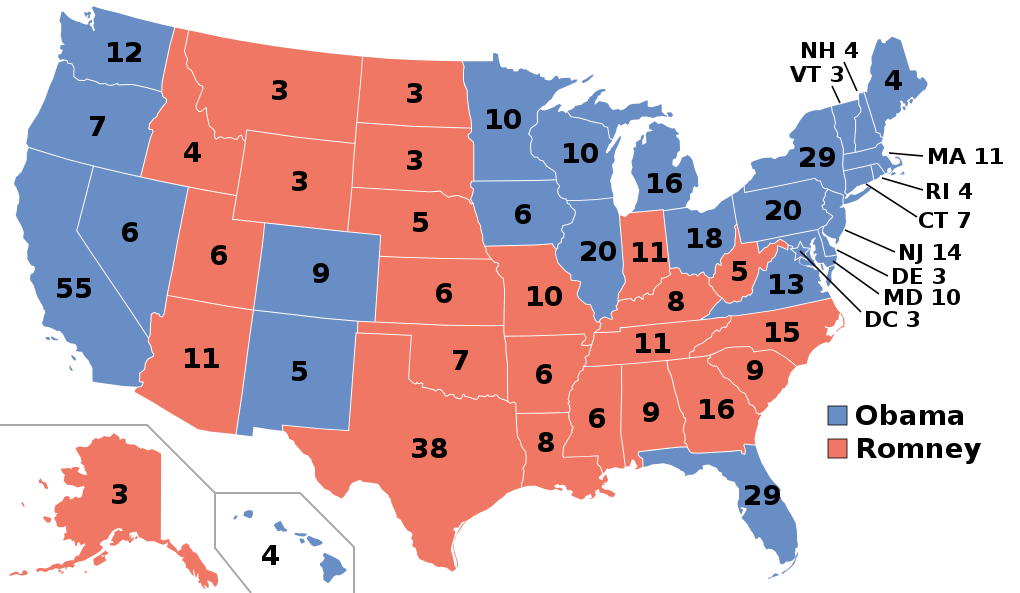 |
| The numbers don't always add up |
So why don't they do something? It's clearly a conscious decision on the part of party strategists to accept the complete loss of the minority and gay vote, and the largest portion of the youth vote. The answer to this question can be found, as can so many other bits of convoluted governance theory in the US, in our national original sin, that Peculiar Institution, slavery. While Wilson and Madison very much preferred a popular election, they recognized that such a proposal stood no chance of success due to the differences in suffrage in the north and the south. At the same time, a system where the President was directly elected by congress ran the risk of an executive beholden to the legislative, diminishing the usefulness of the separation of powers. So they proposed a system where each state would choose a number of electors equal to the number of Senators and Representatives from that state, and those electors would actually cast the votes that elected the executive.
This 'Electoral College' - the term does not appear in the Constitution, but was formalized in federal law in 1845 - is, remarkably, still the system in use today. Now, there are many breathless discussions of how this system could be used to undermine the will of the people - indeed, there is no actual requirement that electors vote for the candidate to whom they are pledged - this is highly unlikely because they are pledged to that candidate for ideological and political reasons. Rather than some kind of inside skulduggery, the Electoral College instead radically changes the demographic realities of a national election. There are about 150 million registered voters in the US, and about 120 million of them can be expected to vote in a Presidential contest. With so many states uncontested 'Red' and 'Blue', a national election isn't dependent on the popular vote, but rather on a few hundred thousand 'swing' votes in highly contested states. And many of these states and regions within them skew to white, christian, rural voters.
You can see the inherent Democratic advantage reflected in the numbers they have locked in already. It's kind of interesting that the vast majority of those 191 starting electoral votes come from just four states - California, New York, Pennsylvania and New Jersey. So you can see quite clearly what this election will be about. The Republicans will be trying to win votes in the Rust Belt, while the Democrats try to exploit changing population dynamics in the Southwest and Southeast.
But with all the dust and smoke and Ben and Bernie in the Primaries, keep this in mind. The campaign is going to be about a few communities in a few states in odd corners of the country. Your vote almost certainly is meaningless - unless it isn't. This could very well be a close run thing.
...

Analysts already conclude that only the 2016 party winner of Florida, Ohio, Virginia, Wisconsin, Colorado, Iowa and New Hampshire is not a foregone conclusion. So, without a change in the system, less than a handful of states will continue to dominate and determine the presidential general election.
ReplyDeleteOver the last few decades, presidential election outcomes within the majority of states have become more and more predictable. Only ten states were considered competitive in the 2012 election.
From 1992- 2012
13 states (with 102 electoral votes) voted Republican every time
19 states (with 242) voted Democratic every time
If this pattern continues, and the National Popular Vote bill does not go into effect,
Democrats only would need a mere 28 electoral votes from other states.
If Republicans lose Florida (29), they would lose.
Population shifts have converted states that were once solidly Republican into closely divided “battleground” states.
There do not appear to be any Democratic states making the transition to voting Republican in presidential races.
Some states have not been been competitive for more than a half-century and most states now have a degree of partisan imbalance that makes them highly unlikely to be in a swing state position.
• 41 States Won by Same Party, 2000-2012
• 32 States Won by Same Party, 1992-2012
• 13 States Won Only by Republican Party, 1980-2012
• 19 States Won Only by Democratic Party, 1992-2012
• 7 Democratic States Not Swing State since 1988
• 16 GOP States Not Swing State since 1988
The National Popular Vote bill would guarantee the presidency to the candidate who receives the most popular votes in the country.
ReplyDeleteEvery vote, everywhere, would be politically relevant and equal in every presidential election. No more distorting and divisive red and blue state maps of pre-determined outcomes. There would no longer be a handful of 'battleground' states where voters and policies are more important than those of the voters in 80%+ of the states that have just been 'spectators' and ignored after the conventions.
Voters in the now 38+ blue or red states of all sizes would become politically relevant.
The National Popular Vote bill would take effect when enacted by states possessing a majority of the electoral votes—270 of 538.
All of the presidential electors from the enacting states will be supporters of the presidential candidate receiving the most popular votes in all 50 states (and DC)—thereby guaranteeing that candidate with an Electoral College majority.
The bill has passed 33 state legislative chambers in 22 rural, small, medium, large, red, blue, and purple states with 250 electoral votes. The bill has been enacted by 11 jurisdictions with 165 electoral votes – 61% of the 270 necessary to go into effect.
http://www.NationalPopularVote.com